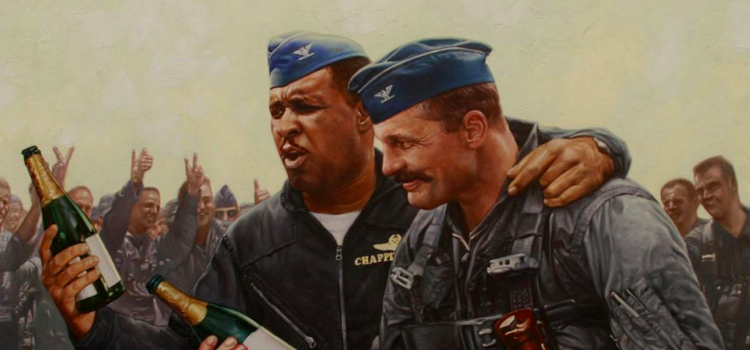The Air Force is now aged well into its seventies and the branch that started as an offshoot of the U.S. Army is looking at having a child of its own — the U.S. Space Force. Even though the mere need for the U.S. Air Force is one that is still debated in some circles, it’s pretty safe to say the service is here to stay, and for good reason. The men, women, and aircraft of the U.S. Air Force have accomplished some of the most incredible feats in military history.
When you look back at the legacy of the USAF, there are so many important, pivotal events that either established the Air Force as one to be reckoned with, cemented the legendary status of some great American heroes, or made the difference when it was needed the most. There’s a reason these moments will live forever in our collective imagination. Like the mythological tales of great heroes setting out to impress the gods, these are the Air Force’s finest moments.
1. The St. Mihiel Offensive – World War I
You have to admit, it’s ballsy to go into combat in a rig made of canvas and popsicle sticks.
(U.S. Air Force)
For four years, the St. Mihiel Salient was a giant bulge in the lines of the Western Front. In 1914, the German Army managed to create a 250-square mile indentation on the front while trying to capture the fortress at Verdun. When the United States joined World War I in 1918, General John J. Pershing demanded an area of the front that was exclusively the responsibility of American forces. He got it.
An important aspect of that battle was the air war over St. Mihiel, the largest air battle of the entire war. 1,476 allied aircraft took on 500 German aircraft over four days in September 1918. The First U.S. Army Air Service took command of air elements from the United States, France, Italy, Great Britain and Portugal. Combined force air power destroyed enemy aviation, achieved complete air superiority, and aided ground forces while denying enemy air reconnaissance assets.
The Salient was itself crushed by American ground troops within those four days.
2. World War II
From the USAF’s raid on the Ploesti Airfields in Romania.
(U.S. Air Force)
An essential element to early Nazi successes in World War II relied on the new tactic of blitzkrieg, which required large but very fast movements of concentrated forces and massive air firepower. Before entering the war, the U.S. Army Air Forces saw the importance of air power in the skies over London and were shown that power in force at Pearl Harbor. After entering the war, the Air Forces were tasked with gaining air superiority, crushing the Germans’ ability to wage war, and prepare Fortress Europe for an allied invasion.
During World War II, being on a bomber crew was deadlier than even landing on the beaches of the Pacific with the U.S. Marines. As the war came home to Germany, the Air Force only stepped up the intensity of the bombing campaign while proving that American airmen and technology were more than a match for the Luftwaffe. By the end of the war, the Nazi air forces struggled to put up a fight as fuel, pilots, and ammunition were in such short supply against the overwhelming air power of the USAAF.
In the Pacific theater, the Air Force immediately brought the pain as fast as they could after the attack on Pearl Harbor. The daring Doolittle Raid started out the war with Japan by reminding them that they weren’t out of the United States’ long reach. The Air Force fought alongside the Navy in as many pitched air battles as were needed, but the real strength of the Air Force came at the end of the Navy and Marine Corps’ island-hopping campaign. As air bases were set up closer and closer to the Japanese Home Islands, Army Air Forces bombers pummeled mainland Japan with firebombs, crippling Japanese industry until two days in August 1945 changed the world forever: the dropping of atomic bombs on Hiroshima and Nagasaki ended the Pacific War for good.
3. The Tuskegee Airmen – World War II
In all your life, you’ll never be this cool.
(U.S. Air Force)
In the days before the integration of the Armed Forces, African-Americans served primarily in support roles, and usually as enlisted men. That all changed in the lead up to World War II when President Roosevelt ordered the Army to begin training black pilots at Tuskegee Army Air Field – in the heart of the segregated South. It was a time when Americans widely believed that black people could not be trained to use advanced technological equipment, especially aircraft.
Not only were the college-educated Tuskegee Airmen able to fly and operate aviation technology, they were really, really good at it. Tuskegee Airmen flew some 15,000 sorties in the skies of Europe and North Africa during World War II, risking their lives and the reputation of their entire race on their performance. Their success rate on bomber escort missions was twice as high as other groups in the 15th Air Force and, over the course of the war, they took down hundreds of enemy planes, thousands of enemy railcars, and even sank an enemy destroyer.
The massive successes of the more than 14,000 Tuskegee Airmen led to the integration of the Armed Forces after the war and Benjamin O. Davis, Jr., one of the first black Amy Air Force pilots, became the first African-American general of the newly-created U.S. Air Force.
4. The Berlin Airlift – Cold War
The Original Grubhub.
The first battle in the ideological war that pit Western Capitalism against Eastern Communism wasn’t fought with guns or bombs, it was fought with food. After WWII, Berlin was divided into four zones, each administered by one of the victorious European Allies. The area surrounding the city was entirely Soviet-dominated. The German capital was, effectively, nestled deep inside Soviet-occupied East Germany. As Cold War tensions mounted, the USSR cut off all land routes to the Western-occupied parts of the city in an effort to starve out the capitalist allies. Any help to Berlin could only come through a dedicated air corridor.
In the days before massive cargo planes, like the C-5 Galaxy, the U.S. Air Force and the Western Allies launched what became known as the Berlin Airlift, a massive coordinated cargo hauling campaign that (at its height) saw an aircraft land in Berlin every single minute. German ground crews were soon able to unload an aircraft within 20 minutes in order to make sure the city was nurtured with the 394,509 tons of food, coal, and other supplies the city would need to survive the almost year-long Soviet siege of the city.
5. MiG Alley – Korean War
During the Korean War, the Air Force was again put to the test. The Nazis developed jet-powered fighters by the end of World War II, but even then, it was an imperfect technology. By the time the Korean War saw Communist forces engage the United Nations Coalition on the Korean Peninsula, both sides were still flying propeller driven aircraft. That soon changed. As the war ground on through December of 1950, the United States still had no jet-powered answer to the Soviet-built MiG-15 jet fighter.
Then, finally, came the F-86 Sabre. The swept-wing design and the skill of UN and American pilots were able to make short work of MiG-15 fighters. In the infamous “MiG Alley” – the Northern area of North Korea, near its border with China – where Soviet, Chinese, and North Korean fighters waited at high altitudes to come down raining death on UN fighters, featured massive jet vs. jet air battles. Air Force F-86 pilots had a stunning 10-1 kill ratio.
6. Operation Bolo – Vietnam War
Robin Olds is the reason for the Air Force’s “Mustache March” tradition.
The early days of the air war over Vietnam didn’t go so well for the USAF. The Vietnam War’s kill ratio is a dismal but disputed 2-1. Air Force sorties coming to the landward side of Vietnam from bases in Thailand were picked up by superior North Vietnamese early warning radar and intercepting Communist planes were able to wait for the incoming Air Force planes. Once inside North Vietnam, Air Force pilots had only their eyes to help guide them. Air Force pilots would always end up on the defensive against skilled North Vietnamese pilots and surface-to-air missile batteries.
Air Force legend and triple ace Robin Olds devised a way to take advantage of the increasing boldness of Vietnamese pilots. In “Bolo,” Olds created what looked like a standard USAF F-105 bombing run to North Vietnam’s radar. Enemy MiG-21s made a beeline for what they thought were the usual F-105 Thunderchief bombers only to find Olds and his fleet of F-4 Phantoms ready for air-to-air combat. Without suffering a single loss, the Air Force downed seven enemy MiG-21s, changing the way the Air Force fought in the air. In the weeks that followed, North Vietnam lost half of its combat planes to U.S. airmen.
7. Operation Desert Storm
Behold: The reason the movie “Jarhead” has no climactic battle scenes.
(U.S. Air Force)
The air war of Operation Desert Storm was one of the most massive and successful air campaigns ever. Since Coalition aircraft could roam the skies in the region virtually unopposed. The buildup of men, materiel, equipment, and aircraft was one of the largest airlift operations in military history (even bigger than the Berlin Airlift). By the time the deadline for Iraq to withdraw from Kuwait came and went, the U.S. Air Force was more than ready to take the initiative.
Starting Jan. 17, 1991, the Air Force launched more than 100,000 sorties against Iraqi targets and dropped more than 88,000 tons of ordnance. Like a modern-day Noah’s Ark story, the Air Force pummeled Iraq for some 40 days and 40 nights. After the U.S. Air Force smashed some 38 Iraqi aircraft, those pilots still in the air fled to Iran (who they just finished an eight-year war with) rather than face the U.S. Air Force in combat. The Gulf War ended in Iraqi defeat on Feb. 23, 1991.
This article originally appeared on We Are The Mighty
More From We Are The Mighty
5 Reasons Why Troops Stick Together After the Military
4 Reasons Why Showering On Deployment is Disgusting
7 of the Greatest Songs Every Veteran Knows
6 Things You’d Take Back Before Leaving the Military
6 Dumb Things Veterans Lie About on the Internet
Follow We Are The Mighty on Twitter
READ NEXT: THE ORIGIN STORY OF EACH BRANCH’S BATTLE CRY





